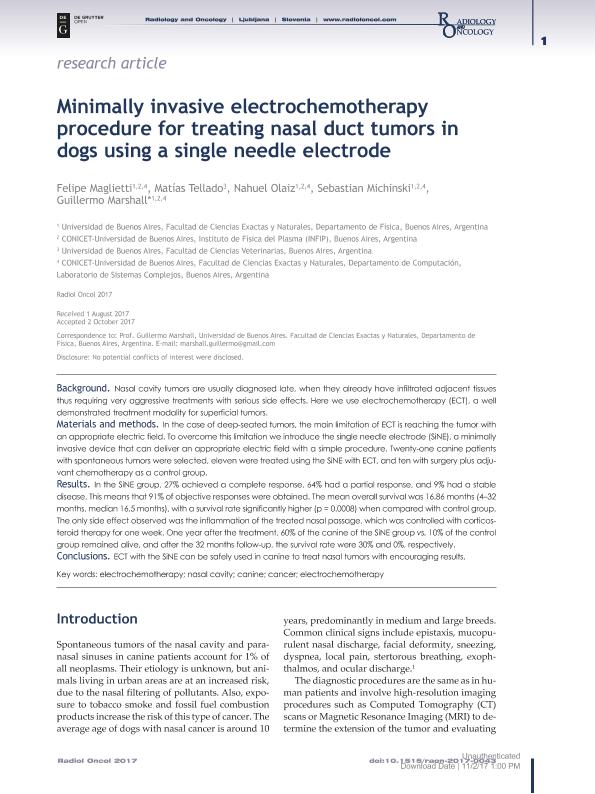Mostrar el registro sencillo del ítem
dc.contributor.author
Maglietti, Felipe Horacio

dc.contributor.author
Tellado, Matías Nicolás

dc.contributor.author
Olaiz, Nahuel Manuel

dc.contributor.author
Michinski, Sebastián Diego

dc.contributor.author
Marshall, Guillermo Ricardo

dc.date.available
2018-04-03T22:15:47Z
dc.date.issued
2017-01
dc.identifier.citation
Maglietti, Felipe Horacio; Tellado, Matías Nicolás; Olaiz, Nahuel Manuel; Michinski, Sebastián Diego; Marshall, Guillermo Ricardo; Minimally invasive electrochemotherapy procedure for treating nasal duct tumors in dogs using a single needle electrode; Association of Radiology and Oncology; Radiology and Oncology; 51; 4; 1-2017; 1-9
dc.identifier.uri
http://hdl.handle.net/11336/40625
dc.description.abstract
Background: Nasal cavity tumors are usually diagnosed late, when they already have infiltrated adjacent tissues thus requiring very aggressive treatments with serious side effects. Here we use electrochemotherapy (ECT), a well demonstrated treatment modality for superficial tumors.
Materials and methods: In the case of deep-seated tumors, the main limitation of ECT is reaching the tumor with an appropriate electric field. To overcome this limitation we introduce the single needle electrode (SiNE), a minimally invasive device that can deliver an appropriate electric field with a simple procedure. Twenty-one canine patients with spontaneous tumors were selected, eleven were treated using the SiNE with ECT, and ten with surgery plus adjuvant chemotherapy as a control group.
Results: In the SiNE group, 27% achieved a complete response, 64% had a partial response, and 9% had a stable disease. This means that 91% of objective responses were obtained. The mean overall survival was 16.86 months (4–32 months, median 16.5 months), with a survival rate significantly higher (p = 0.0008) when compared with control group. The only side effect observed was the inflammation of the treated nasal passage, which was controlled with corticosteroid therapy for one week. One year after the treatment, 60% of the canine of the SiNE group vs. 10% of the control group remained alive, and after the 32 months follow-up, the survival rate were 30% and 0%, respectively.
Conclusions: ECT with the SiNE can be safely used in canine to treat nasal tumors with encouraging results.
dc.format
application/pdf
dc.language.iso
eng
dc.publisher
Association of Radiology and Oncology
dc.rights
info:eu-repo/semantics/openAccess
dc.rights.uri
https://creativecommons.org/licenses/by-nc-nd/2.5/ar/
dc.subject
Electrochemotherapy
dc.subject
Nasal Cavity
dc.subject
Canine
dc.subject
Cancer
dc.subject.classification
Medicina Critica y de Emergencia

dc.subject.classification
Medicina Clínica

dc.subject.classification
CIENCIAS MÉDICAS Y DE LA SALUD

dc.subject.classification
Otras Ciencias Veterinarias

dc.subject.classification
Ciencias Veterinarias

dc.subject.classification
CIENCIAS AGRÍCOLAS

dc.subject.classification
Ingeniería Médica

dc.subject.classification
Ingeniería Médica

dc.subject.classification
INGENIERÍAS Y TECNOLOGÍAS

dc.title
Minimally invasive electrochemotherapy procedure for treating nasal duct tumors in dogs using a single needle electrode
dc.type
info:eu-repo/semantics/article
dc.type
info:ar-repo/semantics/artículo
dc.type
info:eu-repo/semantics/publishedVersion
dc.date.updated
2018-04-03T18:43:27Z
dc.identifier.eissn
1581-3207
dc.journal.volume
51
dc.journal.number
4
dc.journal.pagination
1-9
dc.journal.pais
Eslovenia

dc.journal.ciudad
Ljubljana
dc.description.fil
Fil: Maglietti, Felipe Horacio. Consejo Nacional de Investigaciones Científicas y Técnicas. Oficina de Coordinación Administrativa Ciudad Universitaria. Instituto de Física del Plasma. Universidad de Buenos Aires. Facultad de Ciencias Exactas y Naturales. Instituto de Física del Plasma; Argentina
dc.description.fil
Fil: Tellado, Matías Nicolás. Universidad de Buenos Aires. Facultad de Ciencias Veterinarias; Argentina
dc.description.fil
Fil: Olaiz, Nahuel Manuel. Consejo Nacional de Investigaciones Científicas y Técnicas. Oficina de Coordinación Administrativa Ciudad Universitaria. Instituto de Física del Plasma. Universidad de Buenos Aires. Facultad de Ciencias Exactas y Naturales. Instituto de Física del Plasma; Argentina
dc.description.fil
Fil: Michinski, Sebastián Diego. Consejo Nacional de Investigaciones Científicas y Técnicas. Oficina de Coordinación Administrativa Ciudad Universitaria. Instituto de Física del Plasma. Universidad de Buenos Aires. Facultad de Ciencias Exactas y Naturales. Instituto de Física del Plasma; Argentina
dc.description.fil
Fil: Marshall, Guillermo Ricardo. Consejo Nacional de Investigaciones Científicas y Técnicas. Oficina de Coordinación Administrativa Ciudad Universitaria. Instituto de Física del Plasma. Universidad de Buenos Aires. Facultad de Ciencias Exactas y Naturales. Instituto de Física del Plasma; Argentina
dc.journal.title
Radiology and Oncology
dc.relation.alternativeid
info:eu-repo/semantics/altIdentifier/url/http://www.degruyter.com/view/j/raon.ahead-of-print/raon-2017-0043/raon-2017-0043.xml
dc.relation.alternativeid
info:eu-repo/semantics/altIdentifier/doi/http://dx.doi.org/10.1515/raon-2017-0043
Archivos asociados
